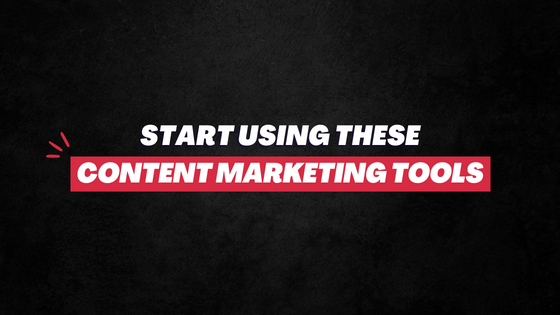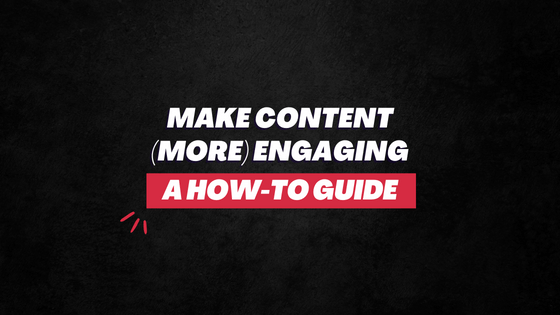Before you go on to create content marketing strategy, you need to define your goals. That’s the first step in the process.
Why do you even want to invest your time, money, and energy in content marketing? What do you want to achieve?
In fact, you’ll really be wasting all your resources if you don’t have a well-defined content marketing goal.
Because if you don’t know your goal, you wouldn’t know if what you’re doing is working or not.
And if you don’t know whether or not your efforts are yielding the required outcomes, you wouldn’t be able to improve.
So, you need to define your content marketing goals and objectives so as to give a framework to your content marketing strategy.
Now, having a content marketing goal is kind of distinct to everyone. It depends on one’s business type, requirement, industry, target audience, product, and some other variables. It also depends on whether they are in B2B or B2C setup.
Moreover, the goals can be of different types. Like short-term goals, long-term goals, primary goals, secondary goals.
But that said, below I have listed 15 popular content marketing goals examples… You can pick and pursue them as long-term or short-term goals, primary or secondary goals – whichever suits your need.
NOTE: “Important metrics to track” below are just basic examples; you should ideally track various other metrics as well depending on your strategy and business model.
1. Increase brand awareness
As we move forward, it will become clearer that those establishments and individuals who have invested heavily in branding – they will outlast all of their competitors.
If you’re not building your brand – no matter what industry you’re in and the kind of business you own – you’re making a fundamental mistake.
You can create a content marketing strategy that revolves around your face, individuality, and stories to increase brand awareness.
Important metrics to track: Brand mention across the web, number of followers on social media, and direct traffic.
2. Increase organic traffic
In general, a lot of people create content marketing strategy to increase their site’s organic traffic.
In this goal, you will have to integrate the elements of SEO into your content strategy. Like keyword research, internal link building, outbound links, and more. Give these two a read (or bookmark them for future reference) –
- Complete SEO Checklist For 2020 + PDF Download
- SEO Writing: 2020 Guide to Create Content That Google Rewards
Important metrics to track: Pageviews, number of visitors, source of traffic.
3. Increase lead generation
After you have people on your site, the next most common thing you would want is their email or contact details.
You can create an effective content marketing strategy with dedicated landing pages and personalized copies to turn the visitors into marketing-qualified leads (MQL).
You can create specific types of content that capture people’s email addresses.
You can spend on paid ads on Google and social media platforms to generate leads.
There are many tactics you can include in your content marketing strategy to drive the desired consumer action.
Recommended Read: 5 Data-Driven Lead Generation Hacks (You Must Use in 2020)
Important metrics to track: Number of visitors on the squeeze/lead gen page, number of people subscribing.
4. Boost sales
Writing sales copy is an art in itself.
It requires the right amount of fluency and flair with elements of persuasion.
For example: The best sales copy talks about the problems the product solves – and not necessarily about the features. It talks about the benefits and not how the product works. And yet we have sales landing pages that unendingly talk about the features and how great the product is.
A high-converting sales page is more consumer-centric rather than product-focused.
An effective content marketing strategy can ensure not just a great sales page but also a thoughtful front end and back end of the funnel – that transfers a user into being a long-term customer.
Important metrics to track: Number of visitors on the sales page, average time spent on the sales page, number of people buying the product, and source of the traffic.
5. Make customer education impactful
This is one of the common from popular content marketing goals set in B2B.
“Education” here includes educating people about your products (that assumingly is complex), how you can solve their pain points, how you can ensure their success, and how they can optimally use your product.
Educating customers will help you increase your product adoption and retention rate.
Moreover, if you’re delivering a personalized education experience to customers, it would also provide you with opportunities to build/grow your brand.
How you can educate customers?
Via tools, resources, courses, surveys, and emails; aka via content.
Important metrics to track: Engagement rate, number of upsells and cross-sells, customer lifetime value, customer churn rate,
6. Increase engagement
Driving engagement is the cornerstone of building a brand.
To that, today, consumers don’t buy products – they buy experience. And engagement plays a big role in shaping that experience.
A good content marketing strategy can attract the right audience and initiate meaningful conversations between the audience and your brand. And this can set the right framework for more sales and business growth.
Important metrics to track: Bounce rate, average session duration, number of shares, number of comments, and number of people taking a desired action.
7. Build brand trust
People know you… But do they trust you?
More brand popularity or awareness doesn’t necessarily mean a lot if you’re not able to translate that attention into the desired outcome.
And this is only possible when people also trust you; when they trust what you’re saying and what you’re selling.
You can integrate storytelling into your content strategy to add more transparency to your message, which will help you progressively build trust value.
A brand that’s trusted enjoys limitless benefits, right FROM higher retention TO business sustainability TO greater returns with less investment in ads/marketing.
Important metrics to track: Returning visitors, customer/client retention rate, price premium, customer/client lifetime value, loyalty program adoption, and brand associations.
8. Increase the customer lifetime value
Depending on your industry and product, there are many ways to increase customer lifetime value. Like, offering better after-sales support, having a loyalty program, having multiple upsell, down-sell, and cross-sell opportunities, and more.
In any case, whatever you do to increase customer lifetime value, content marketing is going to play an integral role in personalizing communication with the consumers and delivering them a better experience.
Important metrics to track: Retention rate, loyalty program adoption, average purchase value, average customer value, and average customer lifespan.
Just blindly posting on social media won’t bring you desired results.
It ought to be more strategic and with a defined objective.
You can create a content marketing strategy to systematically improve the number of followers on platforms like Facebook, Twitter, LinkedIn, Instagram, and more.
Important metrics to track: Number of followers, number of impressions of posts, and growth rate in the number of followers.
10. Attract partners or investors
This could include…
Publishing specific types of content on your website, as well as on social media.
Having dedicated landing pages and personalized copies on each page.
Guest blogging on select relevant websites.
You can run social media ads to reach out to the right people.
There are many ways to attract business partners or investors… All leverage the power of content marketing.
Important metrics to track: Number of people approaching for partnership, the number of visitors on dedicated landing pages, engagement rate, demography, and interest of the traffic.
11. Increase customer loyalty
Customer loyalty is a key element in business sustainability.
It’s also important to build a louder brand. (These few dedicated people who are loyal to your brand will share your content, vouch for your products, and bring you more customers directly or indirectly.)
If your customers aren’t loyal, your retention rate would be low. And since customer retention is cheaper than newer acquisitions, this would be a bad thing for your business financially.
A good content marketing strategy can factor in the needs and preference of your customers and thereon adopt personalized communication that delivers these people high value.
Important metrics to track: Repurchase ratio, customer lifetime value, rate of attrition, and net promoter score.
12. Handle negative PR
You can’t always avoid controversies… Not at least today!
With a defined content marketing strategy, which would be a part of your PR management, you can minimize the impact of negative attention and fasten the recovery process.
You can do this in many ways. Run ads with customer testimonials/reviews, create content that reaffirms your commitment towards CSR, tell your brand story, apologize and introduce changes, and more.
Important metrics to track: Ratio of positive to negative press mentions, social media sentiment analysis around brand mentions, traffic, and engagement to relevant aka positive content.
13. Lead nurturing
Lead generation is just one part of a very large puzzle.
You have acquired a Marketing Qualified Lead (MQL). You now need to transition that into a Sales Qualified Lead (SQL) and then the final conversion.
A proper content marketing strategy can nurture the acquired leads and successfully take them through different customer touchpoints.
So, if you’re generating a lot of leads but very few of them are converting, you can flip the table with winning lead nurturing tactics.
Important metrics to track: Sales cycle time, conversion rate, cost of conversion, and customer lifetime value.
14. A kickass product launch
About to launch a new product?
You can create content marketing strategy to…
…generate hype, attract eyeballs, get more press mentions, and prepare the audience to take certain actions on a particular date/time…
You can use content marketing to create buzz before the launch and boost conversion when the product finally launches.
Important metrics to track: Leads generated, press mentions, mentions on social media, website/page traffic.
What if you want to achieve it all?
You can very certainly have all these content marketing goals together.
You want traffic, you want leads, you want sales… you want it all.
But even in that, you should set priorities.
Which goal do you want to prioritize primarily? Which ones would be your secondary-level priority?
Knowing this will help you create an effective content marketing plan.
For instance, the kind of content you would create when trying to build a brand would be much different when you’re trying to generate leads.
So, you should ideally have one primary content marketing goal and one or more secondary content marketing goals.
All these goals will inevitably fit in different stages of your marketing funnel… And step by step you will achieve them all.
But knowing your first priority aka primary content marketing goal will keep your focus on important metrics. It will help you navigate in the right direction. It will help you create the most relevant pieces of content.
How to choose the right primary content marketing goal?
Again, this process would vary for everyone, depending on their industry, business type, product, target audience, and other factors.
In any case, however, you can find fitting content marketing goals and objectives set by answering these 3 simple questions:
1. What is the biggest digital marketing challenge/problem you’re facing right now?
2. On which stage of the sales funnel you’re stuck?
3. What your closest and most successful competitor is focusing on with its content marketing efforts?
There’s a good chance that your answers to these three questions could be very similar. And that will help you decide on the primary and secondary goals for content marketing you should prioritize.
Final note
It’s also worth noting that once you start achieving your primary content marketing goal, you might discover another problem/challenge/need that requires you to focus on an entirely different goal.
Shift your focus accordingly.
Remember, you should review your content marketing goal anywhere between 4 and 6 months.
So, once you can discover a new problem/challenge/need, you can change the primary and secondary goals of content marketing accordingly.
Hope this blog post provided you with value.
All the best! 🙂
Recommended Read:



